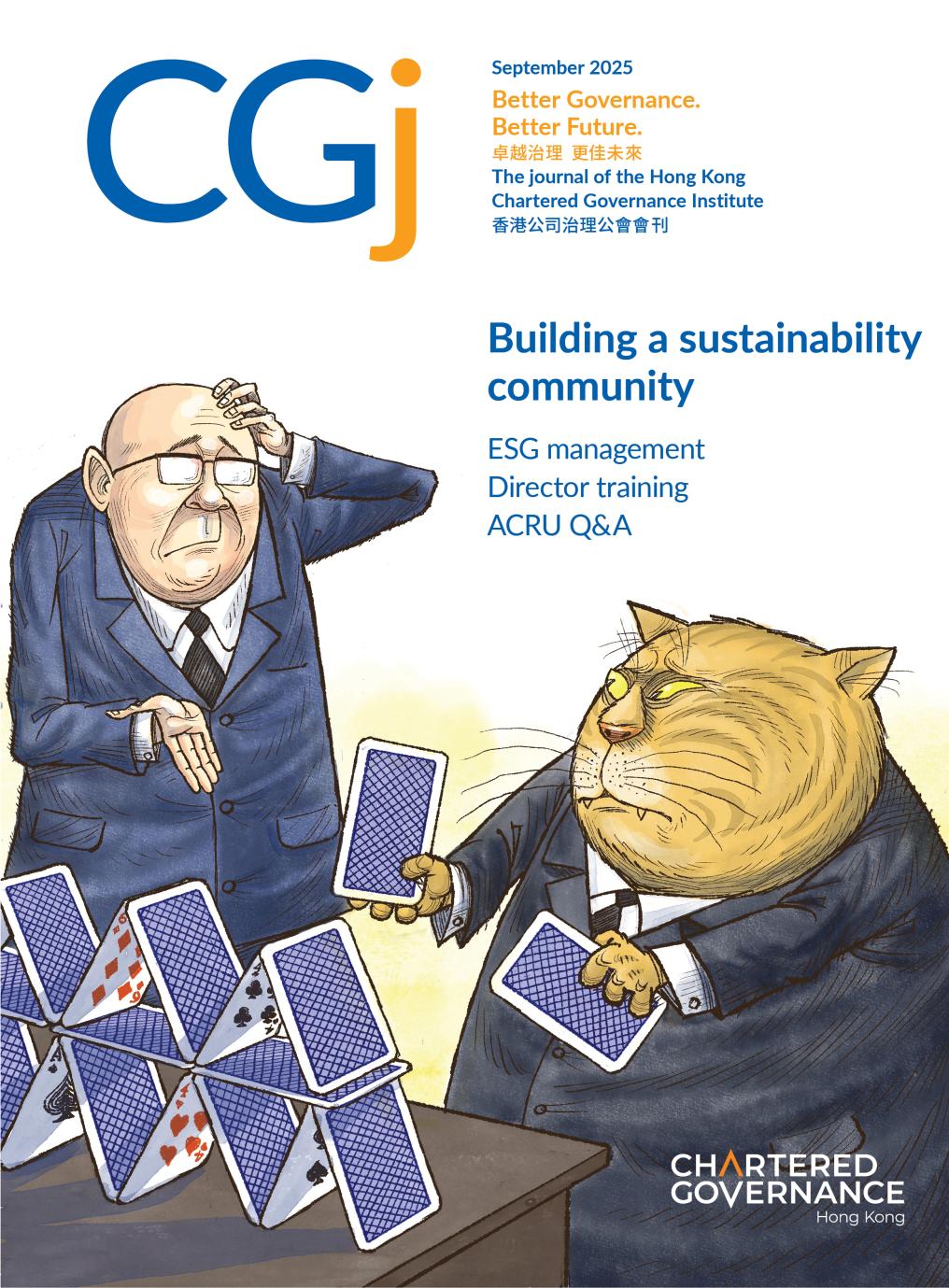
Building a high-impact ESG system
Angel Sze FCG HKFCG(PE), Company Secretary and Head of the ESG Management Committee, Fosun International Ltd, explains how the company embeds ESG governance into every layer of decision-making and disclosure.
Highlights
- a multitiered structure is key to embedding ESG across strategy, oversight and execution
- transparency and stakeholder dialogue go hand in hand, enabling materiality-driven disclosures that earn trust and relevance
- ESG ratings are the levers for benchmarking, internal engagement and long-term system improvement
Placing governance at the forefront
In the ESG narrative, governance is often overshadowed by its more visible siblings, environmental and social. But at Fosun International, we believe that governance should come first, because sound governance is the cornerstone of high-quality ESG development and internationalisation.
Fosun International has established a multitiered governance framework. At the ESG governance level, we have created an ESG Board Committee to assist the Board in guiding and monitoring the implementation of the Group’s ESG work. At the decision-making level, we have set up an ESG Executive Committee to provide decision-making support for the execution of ESG strategies. And, at the execution level, we have also initiated an ESG Management Committee and an ESG Working Group to ensure that appropriate and effective ESG risk management and internal monitoring systems are in place for the full achievement of the Company’s relevant actions.
Transparency as a strategic imperative
Transparency is integral to our strategy. Beyond statutory disclosure, we strive to communicate our ESG story with clarity and precision, from data accuracy and assurance to dialogue with stakeholders.
In addition to the company’s financial condition and operating performance, we fully disclose the specific content of our various ESG practices and have thoroughly integrated transparency into our upgraded ESG strategy, emphasising clear and accurate sustainability disclosure, as well as data verification, in order to build social trust.
We also continue to communicate with our stakeholders, listen to their voices, respond to their concerns and establish a relationship of mutual trust. We communicate in a ‘multidimensional, multidirectional and multichannel’ manner, including ESG reverse roadshows, and engage in exchanges with academic and financial institutions’ sustainability teams. The feedback we receive informs our materiality assessment analysis of ESG issues, and subsequently assists us to further optimise our ESG work and disclosure.
Aligning with global and local standards
Along with the requirements of Hong Kong’s Main Board Listing Rules, our reporting is aligned with international benchmarks. We incorporate the United Nations’ Sustainable Development Goals, the Global Reporting Initiative reporting standards and mainstream ESG ratings methodologies into our ESG reports, and have steadily improved the content and quality of our ESG reporting disclosures.
We have also issued a Climate Information Disclosures Report for each of the past three years, benchmarked against Part D of Appendix C2 (Climate-related Disclosures) of the Listing Rules. These reports also make reference to the recommendations of the Task Force on Climate-related Financial Disclosures framework, as well as the International Financial Reporting Standards’ Climate-related Disclosures Requirements (IFRS S2).
In terms of the Chinese mainland, the latest domestic ESG regulatory disclosure requirements are strongly aligned with those of the International Sustainability Standards Board, while also embracing local characteristics, particularly in the areas of rural revitalisation and technological innovation. We closely monitor and respond to the mainland’s evolving regulatory requirements.
By aligning with both global and local standards, we believe that efforts to improve the width, depth and transparency of our ESG reporting will result in a greater level of stakeholder trust, as well as boost our reputation.
Creating a strategic framework
To put ESG into action, we have developed a strategic framework called Create IMPACT. This sustainable development strategy focuses on six key directions – innovation-driven, mindful operation, people and partner oriented, advanced governance, climate and planet positive, and transparency.
Through this framework, we strive to create a more positive impact and to promote sustainable growth. Each of the six pillars serves as a guiding force for our ESG strategies, targets and actions across the Fosun Group. For instance, we are driving technological innovation to develop sustainable business solutions, enhancing responsible operational practices, and strengthening engagement with stakeholders and communities. We also highlight sound governance, proactive climate action and ethical transparency to support long-term value creation.
Overall, Fosun International has constructed an ESG practice system that encompasses both international norms and local characteristics through strategic integration, alignment of standards and transparent communication, and we disclose these in detail in our ESG reports.
ESG ratings as tools for growth
As society’s expectations of the role of companies intensifies, investors and consumers are placing increasing emphasis on ESG performance. Rather than viewing ESG ratings as merely a tick-box compliance task, we treat it as a strategic management tool. ESG ratings are a valuable resource to help stakeholders better understand a company’s corporate ESG practices.
Participating in market ESG ratings helps companies benchmark against their industry peers and attain a more comprehensive grasp of international standards. In fact, many ratings agencies set criteria that exceed regulatory requirements. For example, Hong Kong’s Corporate Governance Code now requires at least one director of a different gender on the board, whereas most international ESG ratings providers call for a minimum gender diversity ratio of 30% or more.
“As society’s expectations of the role of companies intensifies, investors and consumers are placing increasing emphasis on ESG performance.”
Fostering internal engagement
By acknowledging the value of ESG ratings, companies can enhance the management of their ESG systems. With the help of ratings tools, they can stay informed about international best practices and gradually optimise their internal regulations and risk management processes.
Many ESG ratings requirements go beyond simply stating whether or not a company has relevant ESG policies in place – they also require evidence of concrete implementation and continuous improvement. ESG ratings are not just about passively responding to questionnaires and obtaining scores, instead, the ratings methodology is about examining the gap between the pace of a company’s ESG practices and market expectations that surpass regulatory compliance. This process encourages companies to identify areas for progress and improvement, while ensuring their internal frameworks are effectively and comprehensively carried out to achieve genuine ESG risk management and control.
As a company’s ESG ratings improve and market recognition is gained, employees at all levels tend to develop a stronger sense of mission and engagement. This, in turn, further reinforces the organisation’s commitment to advancing its ESG journey.
Angel Sze FCG HKFCG(PE), Company Secretary and Head of the ESG Management Committee
Fosun International Ltd
复星国际公司秘书、复星ESG管理委员会主任史美明 FCG HKFCG(PE) 说明公司如何将ESG治理融入决策和披露的各个层面。
Highlights
- 多层次结构是将 ESG 融入战略、监督与执行的关键
- 保持透明度,同时与利益相关方对话,让企业得以披露重要的 ESG 议题,从而赢得信任,并能与时并进
- ESG评级帮助企业对标、促进内部参与,有助长期改进体系
将治理置于首位
在ESG的叙事中,治理常常被更为显眼的环境与社会两个方面所掩盖。但在复星国际,我们认为治理应当放在首位,因为健全的治理是高质量ESG发展与国际化的基石。
复星国际建立了多层次的治理架构。 在ESG治理层面,我们设立了ESG董事委员会,协助董事会指导和监督集团落实ESG工作。在决策层面,我们设立了ESG决策委员会,为ESG战略的实施提供决策支持。在执行层面,我们还设立了ESG管理委员会与ESG工作小组,确保公司能够建立适当且有效的ESG风险管理与内部监控体系,全面落实相关行动。
透明度作为战略要务
透明度是我们战略的重要组成部分。 除了法定披露之外,我们努力以清晰准确的方式传达我们的ESG故事,既注重数据的准确性和质量保证,也与利益相关方保持对话。
除了公司财务状况和经营表现外,我们也全面披露各项ESG实践的具体内容,且已将透明度深度融合进升级后的ESG战略,强调清晰准确的可持续发展披露以及数据验证,以建立社会信任。
我们还持续与利益相关方沟通,倾听他们的声音,回应他们的关切,建立互信关系。我们的沟通采取‘多维、多向、多渠道’的方式,包括ESG反向路演,并与学术界及金融机构的可持续发展团队进行交流。收到的意见能帮助我们对ESG议题作重要性评估,进而帮助我们进一步优化ESG工作和披露。
与全球和本地标准接轨
除了符合香港主板上市规则的要求外,我们的报告还对标国际基准。我们将联合国可持续发展目标、全球报告倡议(GRI)报告标准及主流ESG评级方法纳入ESG报告中,持续稳步提升ESG报告披露的内容和质量。
过去三年,我们还每年发布复星国际气候信息披露报告,对标香港联交所《主板上市规则》附录C2的D部分(气候相关披露),参考了气候相关财务信息披露工作组(TCFD)的建议框架及《国际财务报告准则S2号-气候相关披露》(IFRS S2)的要求。
中国内地最新的ESG监管披露要求与国际可持续发展准则理事会(ISSB)的标准高度契合,同时兼顾本地特色, 尤其在乡村振兴和科技创新领域。我们持续跟踪并配合中国内地监管政策动态,通过对接国际与本地准则,着力提升ESG报告的广度、深度及透明度。此举将增强利益相关方信任度, 并提升企业声誉。
构建战略框架
为了将ESG付诸实践,我们制定了名为Create IMPACT的战略框架。这一可持续发展战略聚焦于六大关键方向—创新驱动、责任运营、以人为本、精益治理、绿色发展以及透明真实。
通过该框架,我们致力于创造更积极的影响,促进可持续增长。六大关键方向为集团的ESG策略、目标与行动提供了指引。例如,我们推动技术创新以开发可持续的商业解决方案,提升负责任的运营实践, 并加强与利益相关方及社区的沟通与合作。同时,我们高度重视健全的公司治理、积极践行气候行动、 坚守商业道德并保持透明,以支持企业长期价值创造。
整体而言,复星国际通过战略融合、标准对齐及透明沟通,构建了兼具国际规范与本地特色的ESG实践体系,并在ESG报告中详尽披露相关内容。
ESG评级作为增长工具
随着社会对企业的期望不断提升, 投资者和消费者对企业的ESG表现也越来越关注。我们不将评级视为单纯的合规形式主义,而是作为一种战略管理工具。ESG评级是帮助利益相关方更好了解企业ESG实践的重要资源。
参与市场ESG评级有助企业与同行业竞争者进行对标,深入了解国际标准。事实上,许多评级机构设定的标准甚至超出监管要求。例如,香港《企业管治守则》现要求董事会中至少有一名不同性别的董事,而大多数国际ESG评级机构则要求性别多元比例最低达到30%或以上。
随着社会对企业的期望不断提 升,投资者和消费者对企业的 ESG 表现也越来越关注
促进内部参与
企业认识到ESG评级的价值,便能加强ESG体系的管理。借助评级工具,企业可及时掌握国际最佳实践,逐步优化内部规章和风险管理流程。
许多ESG评级要求不仅仅关注企业是否制定了相关ESG政策,还要求提供具体执行和持续改进的证据。 ESG评级的方式,并非只靠企业被动地回答问卷和获取分数,还要审视企业ESG管理的步伐与市场期望之间的差距;而市场对企业的期望,并不止于符合监管规则。评级过程鼓励企业发现改进空间,确保内部框架得到有效全面的执行,实现真正的ESG风险管控。
随着企业ESG评级的提升和市场认可度的增强,企业不同层级的员工会有更高的使命感与参与度,进而进一步推动企业推进ESG发展的决心。
史美明 FCG HKFCG(PE),公司秘书、ESG管理委员会主任
复星国际


